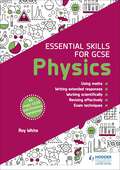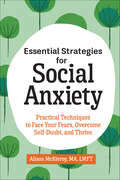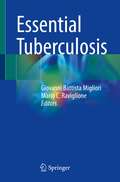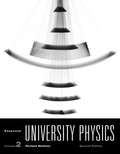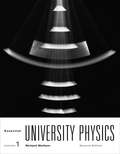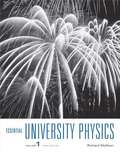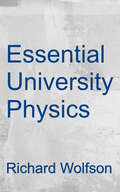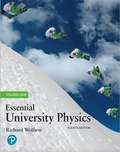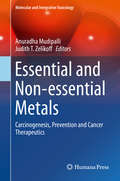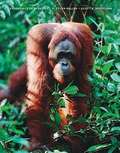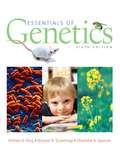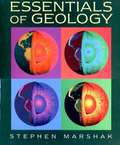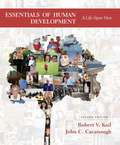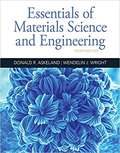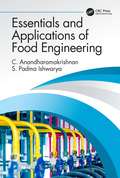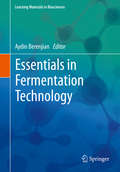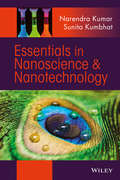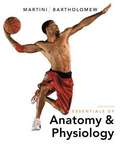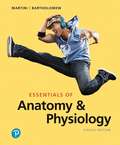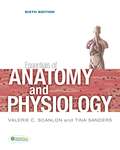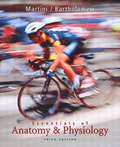- Table View
- List View
Essential Skills for GCSE Physics
by Roy WhiteBuild essential maths, literacy and working scientifically skills to boost marks in GCSE Biology and ensure that students reach their full potential.Suitable for all specifications, this skills book provides additional support and will help to:- Sharpen mathematical skills with plenty of practice questions and coverage of all the maths techniques needed for the exams.- Improve literacy skills with tips on how to write longer answers, plus peer-assessment marking activities.- Develop the working scientifically skills needed to plan, carry out and evaluate practical experiments, in order to secure the maximum number of marks.- Build confidence by putting skills into practice; using our three-step formula students will progress from worked examples to guided questions and exam-style questions, with fully-worked solutions in the book.- Raise performance in the exams with practical advice on how to revise effectively and tips on understanding the questions, command words and assessment objectives.
Essential Strategies for Social Anxiety: Practical Techniques to Face Your Fears, Overcome Self-Doubt, and Thrive
by Alison McKleroyEmbrace confidence—proven strategies to break free from social anxietySocial connections are an integral part of a joyful life, yet when you're held back by self-conscious thoughts and feelings, you can get stuck in a pattern of avoiding social situations. Essential Strategies for Social Anxiety provides you with an effective toolbox to face your fears and feel confident whether you're having a conversation, interviewing for a job, or speaking publicly.Drawing on a variety of practices—like CBT, ACT, and mindfulness—this guide not only teaches you all about social anxiety but also helps you employ actionable techniques to transform it. Learn to calm both body and mind, silence your inner critic, and restructure negative thoughts with practice dialogues, exposure exercises, meditation, and more.Essential Strategies for Social Anxiety features:Exercises for everyone—No matter how your social anxiety manifests, discover powerful ways to overcome it and connect with people in a more comfortable way.Easy-to-follow advice—Each chapter covers a different approach to dealing with your social anxiety, with step-by-step exercises to get the results you want in your life.Everyday examples—Get inspired by real-life anecdotes that demonstrate how these techniques have helped other people achieve breakthroughs in dealing with social anxiety.Start down the path to confidence and joy in your social life with this easy-to-use guide.
Essential Tuberculosis
by Mario C. Raviglione Giovanni Battista MiglioriThis textbook covers the full spectrum of tuberculosis-related topics in a comprehensive yet easy-to-follow, readily accessible format. Filling a significant gap in tuberculosis literature, it addresses tuberculosis sensu latu, mirroring the content of the London Queen Mary University tuberculosis Diploma.Covering all aspects related to this condition, from prevention, diagnosis and treatment to public and global health, the book provides a broad overview of tuberculosis management. Further, it includes a wealth of case studies and exercises, making it an essential guide for all staff involved in tuberculosis management. Written by an international and interdisciplinary panel of experts, the book appeals to a broad readership including students, postdoctoral fellows, clinicians, researchers, and nurses, as well as public health officers working in tuberculosis control programs.
Essential University Physics (Volume #2)
by Richard WolfsonRichard Wolfson's Essential University Physics, Second Edition is a concise and progressive calculus-based physics textbook that offers clear writing, great problems, and relevant real-life applications. This text is a compelling and affordable alternative for professors who want to focus on the fundamentals and bring physics to life for their students. Essential University Physics focuses on the fundamentals of physics, teaches sound problem-solving skills, emphasizes conceptual understanding, and makes connections to the real world. The presentation is concise without sacrificing a solid introduction to calculus-based physics. New pedagogical elements have been introduced that incorporate proven results from physics education research. Features such as annotated figures and step-by-step problem-solving strategies help students master concepts and solve problems with confidence. The Second Edition features dramatically revised and updated end-of-chapter problem sets, significant content updates, new Conceptual Examples, and additional Applications, all of which serve to foster student understanding and interest. Essential University Physics is offered as two paperback volumes, available shrink-wrapped together, or for sale individually. This package contains: Essential University Physics: Volume 2, Second Edition (which includes Chapters 20-39)
Essential University Physics, 2e, Volume 1
by Richard WolfsonRichard Wolfson's Essential University Physics, Second Edition, is a concise and progressive calculus-based physics textbook that offers clear writing, great problems, and relevant real-life examples. The text is compelling and affordable, focusing on the fundamentals and bringing physics to life.
Essential University Physics: Volume 1
by Richard WolfsonRichard Wolfson’s Essential University Physics, Third Edition is a concise and progressive calculus-based physics textbook that offers clear writing, great problems, and relevant real-life applications in an affordable and streamlined text. Essential University Physics teaches sound problem-solving skills, emphasizes conceptual understanding, and makes connections to the real world. Features such as annotated figures and step-by-step problem-solving strategies help students master concepts and solve problems with confidence. <P><P>Essential University Physics is offered as two paperback volumes available together or for sale individually. <P><P>Also available with MasteringPhysics <P><P>MasteringPhysics from Pearson is the leading online homework, tutorial, and assessment system, designed to improve results by engaging students before, during, and after class with powerful content. Instructors ensure students arrive ready to learn by assigning educationally effective content before class, and encourage critical thinking and retention with in-class resources such as Learning Catalytics. Students can further master concepts after class through assignments that provide hints and answer-specific feedback. The Mastering gradebook records scores for all automatically graded assignments in one place, while diagnostic tools give instructors access to rich data to assess student understanding and misconceptions. <P><P>Mastering brings learning full circle by continuously adapting to each student and making learning more personal than ever–before, during, and after class.
Essential University Physics: Volume 2
by Richard WolfsonRichard Wolfson’s Essential University Physics, Third Edition is a concise and progressive calculus-based physics textbook that offers clear writing, great problems, and relevant real-life applications in an affordable and streamlined text. Essential University Physics teaches sound problem-solving skills, emphasizes conceptual understanding, and makes connections to the real world. Features such as annotated figures and step-by-step problem-solving strategies help students master concepts and solve problems with confidence. Essential University Physics is offered as two paperback volumes available together or for sale individually. Also available with MasteringPhysics MasteringPhysicsfrom Pearson is the leading online homework, tutorial, and assessment system, designed to improve results by engaging students before, during, and after class with powerful content. Instructors ensure students arrive ready to learn by assigning educationally effective content before class, and encourage critical thinking and retention with in-class resources such as Learning Catalytics. Students can further master concepts after class through assignments that provide hints and answer-specific feedback. The Mastering gradebook records scores for all automatically graded assignments in one place, while diagnostic tools give instructors access to rich data to assess student understanding and misconceptions.
Essential University Physics: Volume One
by Richard WolfsonFocus on the fundamentals and help students see connections between problem types Richard Wolfson’s Essential University Physics is a concise and progressive calculus-based physics textbook that offers clear writing, great problems, and relevant real-life applications in an affordable and streamlined text. The book teaches sound problem-solving strategies and emphasizes conceptual understanding, using features such as annotated figures and step-by-step problem-solving strategies. Realizing students have changed a great deal over time while the fundamentals of physics have changed very little, Wolfson makes physics relevant and alive for students by sharing the latest physics applications in a concise and captivating style. The 4th Edition incorporates research from instructors, reviewers, and thousands of students to expand the book’s problem sets and consistent problem-solving strategy. A new problem type guides students to see patterns, make connections between problems that can be solved using similar steps, and apply those steps when working problems on homework and exams. New digital tools and the interactive Pearson eText increase student interactivity to help them develop confidence in solving problems, deepen their conceptual understanding, and strengthen quantitative-reasoning skills. Essential University Physics is offered as two paperback volumes available together or for sale individually. Also available with Mastering Physics By combining trusted author content with digital tools and a flexible platform, Mastering personalizes the learning experience and improves results for each student.Now providing a fully integrated experience, the eText is linked to every problem within Mastering for seamless integration between homework problems, practice problems, textbook, worked examples, and more. Note: You are purchasing a standalone product; Mastering Physics does not come packaged with this content. Students, if interested in purchasing this title with Mastering Physics , ask your instructor for the correct package ISBN and Course ID. Instructors, contact your Pearson representative for more information.
Essential and Non-essential Metals
by Anuradha Mudipalli Judith T. ZelikoffThis book aims to present current state of understanding of the role of metals in human health and disease. As it will be difficult to cover all of the metals, about two scores of them, the authors will instead provide a detailed analysis of a select set of essential (Calcium, Magnesium, Selenium, Iron, copper and Zinc) and non-essential metals (Nickel, Chromium, Cadmium and Arsenic, Tungsten and Asbestos). Each chapter will have a dedicated section focusing on the binary role that some of these metals play, their carcinogenic and cancer therapeutics, by integrating epidemiological, experimental evidence with special emphasis and focus on molecular mechanisms involved in these processes. The biological analysis will also include emerging lines of evidence such as micro RNAS, kinase families, receptors, endoplasmic, mitochondrial players and epigenetics. As part of integrating the human, experimental and mechanistic data, as well as a detailed analysis into the modes of action for different cancer outcomes will be discussed in each chapter wherever deemed feasible. These approaches are ones in which no other book in this area has attempted to do.
Essentials Of Ecology
by Scott Spoolman G. Tyler MillerAn ideal alternative to ecology texts that tend to be too difficult for non-majors, this succinct 11-chapter, full-color textbook covers scientific principles and concepts, ecosystems, evolution, biodiversity, population ecology, and more. Sustainability is the integrating theme and co-authors G. Tyler Miller and Scott Spoolman inspire students to take a positive approach toward finding and implementing useful environmental solutions in their own lives and in their careers. Updated with new information, art, and Good News examples, the text engages and motivates students with vivid case studies and hands-on quantitative exercises. The concept-centered approach transforms complex environmental topics and issues into key concepts that students will understand and remember. Important Notice: Media content referenced within the product description or the product text may not be available in the ebook version.
Essentials Of Fire Fighting
by Ifsta StaffIFSTA’s Essentials of Fire Fighting, 6th Edition is the most complete and comprehensive Firefighter I and II text on the market. This new edition is completely revised to meet the 2013 edition of NFPA 1001 and brings the most trusted in-depth knowledge content to students and instructors. The manual is 21 chapters and has 1,400 pages. Key features includes: Separation and clear identification of FFI and FFII content; Updated content, skills, and tactics that reflect the latest research from NIST and UL; A student-focused design that incorporates high quality photos and illustrations, photos enhanced with graphics, and improved tables make content more relevant to visual learners; Key terms in the margins, review questions at the end of each chapter, skill sheets and engaging case histories designed to enhance student understanding; Warnings, cautions, and Safety Alerts emphasize firefighter safety for new firefighters who are mastering the 192 FFI and FFII skills
Essentials Of Genetics (Sixth Edition)
by William S. Klug Michael Cummings Charlotte SpencerBalancing classical and modern genetics,Essentials of Genetics helps readers understand basic genetics concepts, apply those concepts to genetics problems, and recognize the logic behind them. This succinct treatment features coverage of new research that will capture readers' interests. Mendelian (transmission) genetics, and modern molecular genetics with analytical reasoning woven into discussions, plus references to classical experiments and recent applications. Helps readers connect the science of genetics to the issues of today. Modernizes treatment of timely topics, including genomics, bioinformatics, proteomics (chapter 18), applications and ethics of genetic engineering (chapter 19); updated and extended coverage of gene regulation (chapter 15), cancer genetics (chapter 16). Features beautifully redesigned illustrations throughout, helping readers understand concepts more clearly. A useful reference for anyone interested in learning more about genetics.
Essentials Of Geology
by Stephen MarshakIn this introductory textbook, Marshak (University of Illinois) incorporates the theory of plate tectonics and the concept of Earth science systems into discussions of rock types, volcanoes and earthquakes, crustal deformation and mountains, energy and mineral resources, water, ice, global change and other standard topics. Color photographs and diagrams illustrate the major ideas of the book, and a companion CD-ROM contains animated clips representing the processes described in the text.
Essentials Of Human Development: A Life-span View (Mindtap Course List)
by Robert V. KailESSENTIALS OF HUMAN DEVELOPMENT: A LIFE-SPAN VIEW, 2nd Edition fills the need for a shorter text that emphasizes the essential, defining features of modern research and theory in human development. Using a modified chronological approach and emphasizing the biopsychosocial framework, the text provides: a readable account of human development across the life span; conceptual foundations that enable students to become critical interpreters of developmental information; and an introduction to relevant research and its application to key issues. The text also emphasizes the application of human development research across diverse professional settings, making it ideal for students who are pursuing a career related to psychology or areas such as education, health, and human sciences. Succinct and filled with real-life examples, this text will capture your students' interest while introducing them to the essential issues, forces, and outcomes that make us who we are.
Essentials Of Materials Science And Engineering
by Donald R. Askeland Wendelin J. WrightDiscover why materials behave the way they do with ESSENTIALS OF MATERIALS SCIENCE AND ENGINEERING, 4TH Edition. This books focuses on materials engineering to explain how to process materials to suit your designs. Rather than simply memorizing facts or lumping materials into broad categories, you gain an understanding of the whys and hows behind materials science and engineering. This knowledge of materials science provides an important framework for understanding the principles used today to engineer materials. Detailed solutions and meaningful examples assist you in learning principles while significant end-of-chapter problems provide ample practice. MindTap digital resources help you learn on your terms with an interactive eBook and personalized learning tools.
Essentials Of Micro- and Nanofluidics: With Applications to the Biological and Chemical Sciences
by A. Terrence ConliskThis textbook introduces students to the basic physical principles to analyse fluid flow in micro- and nano-size devices. This is the first book that unifies the thermal sciences with electrostatics and electrokinetics and colloid science; electrochemistry; and molecular biology. Key concepts and principles are discussed, such as the essentials of viscous flows, introductory electrochemistry, heat and mass transfer phenomena, elements of molecular and cell biology and much more. State-of-the-art analytical and computational approaches to problems in all of these areas are presented, especially electrokinetic flows, and examples are given of the use of these approaches to design devices used for rapid molecular analysis, biochemical sensing, drug delivery, DNA analysis, the design of an artificial kidney and other transport phenomena. There are exercise problems and modern examples of applications, as well as a solutions manual available for qualified instructors.
Essentials Of Sociology 11th Edition
by James M. HenslinA Down-to-Earth Approach James Henslin shares the excitement of sociology in Essentials of Sociology: A Down-to-Earth Approach, 11/e. With his acclaimed "down-to-earth" approach and personal writing style, the author highlights the sociology of everyday life and its relevance to students' lives. With wit, personal reflection, and illuminating examples, Henslin stimulates students'' sociological imagination so they can better perceive how the pieces of society fit together. In addition to this trademark down-to-earth approach, other distinctive features include: comparative perspectives, the globalization of capitalism, and visual presentations of sociology. MySocLab is an integral part of the Henslin learning program. Engaging activities and assessments provide a teaching a learning system that helps students see the world through a sociological lens. With MySocLab, students can develop critical thinking skills through writing, explore real-world data through the new Social Explorer, and watch the latest entries in the Core Concept Video Series. Revel from Pearson is a new learning experience designed for the way today''s students read, think, and learn. Revel redesigns familiar and respected course content and enriches it for today''s students with new dynamic, rich-media interactives and assessments. The result is improved student engagement and improved learning. Revel for Henslin will be available for Fall 2014 classes. This program will provide a better teaching and learning experience-for you and your students. It: Personalizes Learning with MySocLab: MySocLab is an online homework, tutorial, and assessment program. It helps students prepare for class and instructor gauge individual and class performance. Explores a A Down-to-Earth Approach: This title highlights the sociology of everyday life and its relevance to students' lives. Improves Critical Thinking: Features throughout help build critical thinking skills. Understands Social Change: An important theme of the text, social change over time, examines what society was previously like, how it has changed, and what the implications are for the present and future. ALERT: Before you purchase, check with your instructor or review your course syllabus to ensure that you select the correct ISBN. Several versions of Pearson's MyLab & Mastering products exist for each title, including customized versions for individual schools, and registrations are not transferable. In addition, you may need a CourseID, provided by your instructor, to register for and use Pearson's MyLab & Mastering products. Packages Access codes for Pearson's MyLab & Mastering products may not be included when purchasing or renting from companies other than Pearson; check with the seller before completing your purchase. Used or rental books If you rent or purchase a used book with an access code, the access code may have been redeemed previously and you may have to purchase a new access code. Access codes Access codes that are purchased from sellers other than Pearson carry a higher risk of being either the wrong ISBN or a previously redeemed code. Check with the seller prior to purchase.
Essentials and Applications of Food Engineering
by C. Anandharamakrishnan S. Padma IshwaryaEssentials & Applications of Food Engineering provides a comprehensive understanding of food engineering operations and their practical and industrial utility. It presents pertinent case studies, solved numerical problems, and multiple choice questions in each chapter and serves as a ready reference for classroom teaching and exam preparations. The first part of this textbook contains the introductory topics on units and dimensions, material balance, energy balance, and fluid flow. The second part deals with the theory and applications of heat and mass transfer, psychrometry, and reaction kinetics. The subsequent chapters of the book present the heat and mass transfer operations such as evaporation, drying, refrigeration, freezing, mixing, and separation. The final section focuses on the thermal, non-thermal, and nanotechnology-based novel food processing techniques, 3D food printing, active and intelligent food packaging, and fundamentals of CFD modeling. Features Features 28 case studies to provide a substantial understanding of the practical and industrial applications of various food engineering operations Includes 178 solved numerical problems and 285 multiple choice questions Highlights the application of mass balance in food product traceability and the importance of viscosity measurement in a variety of food products Provides updated information on novel food processing techniques such as cold plasma, 3D food printing, nanospray drying, electrospraying, and electrospinning The textbook is designed for undergraduate and graduate students pursuing Food Technology and Food Process Engineering courses. This book would also be of interest to course instructors and food industry professionals.
Essentials in Fermentation Technology (Learning Materials in Biosciences)
by Aydin BerenjianThis textbook teaches the principles and applications of fermentation technology, bioreactors, bioprocess variables and their measurement, key product separation and purification techniques as well as bioprocess economics in an easy to understand way. The multidisciplinary science of fermentation applies scientific and engineering principles to living organisms or their useful components to produce products and services beneficial for our society. Successful exploitation of fermentation technology involves knowledge of microbiology and engineering. Thus the book serves as a must-have guide for undergraduates and graduate students interested in Biochemical Engineering and Microbial Biotechnology
Essentials in Nanoscience and Nanotechnology
by Narendra Kumar Sunita KumbhatThis book describes various aspects of nanoscience and nanotechnology. It begins with an introduction to nanoscience and nanotechnology and includes a historical prospective, nanotechnology working in nature, man -made nanomaterial and impact of nanotechnology illustrated with examples. It goes on to describes general synthetic approaches and strategies and also deals with the characterization of nanomaterial using modern tools and techniques to give basic understanding to those interested in learning this emerging area. It then deals with different kinds of nanomaterial such as inorganics, carbon based-, nanocomposites and self-assembled/supramolecular nano structures in terms of their varieties, synthesis, properties etc. In addition, it contains chapters devoted to unique properties with mathematical treatment wherever applicable and the novel applications dealing with information technology, pollution control (environment, water), energy, nanomedicine, healthcare, consumer goods etc.
Essentials of Anatomy & Physiology (Sixth Edition)
by Edwin F. Bartholomew Frederic H. MartiniThe Sixth Edition of Essentials of Anatomy & Physiology introduces the essential concepts needed for an understanding of the human body and helps students place information in a meaningful context, develop their problem-solving skills, and prepare for a career in a medical or allied health field.
Essentials of Anatomy and Physiology
by Frederic Martini Edwin BartholomewGuide students through a challenging course in Anatomy & Physiology to a future in healthcare Celebrated for its precise illustrations,emphasis on integration, and engaging clinical content, Essentials of Anatomy & Physiology is crafted especially for students with no prior knowledge of anatomy & physiology and little science background. <P><P> The 8th Edition guides students through tough A&P topics, helping them retain challenging content in the fast-paced one-semester A&P course. The new edition draws on the outstanding art and hallmark features from the text to create interactives and digital assets that walk students through complicated art and help them to understand difficult concepts. New Build Your Knowledge Interactivesfocus on how the body systems work together to maintain homeostasis. New Spotlight Figure Videos take a popular, visually driven feature from the book and add annotation and narration to break it down for students in an organized, systematic way. .
Essentials of Anatomy and Physiology
by Gary A. Thibodeau Kevin T. Patton Matthew M. DouglasEssentials of Anatomy & Physiology is a new text based on profound respect for both the teacher and the student. That respect is coupled with an excitement for the subject matter honed by the authors during decades of teaching and writing about anatomy and physiology.
Essentials of Anatomy and Physiology
by Valerie C. Scanlon Tina SandersLeading the way for 20 years with unsurpassed clarity, content, and completeness. Fun to teach and easy to study, this popular text delivers a clear, concise presentation of must-know content with an superb art program, complete with the textual and elect
Essentials of Anatomy and Physiology (3rd Edition)
by Edwin F. Bartholomew Frederic H. MartiniNew edition of a text that introduces the specialized terms and basic concepts and principles needed to understand human anatomy and physiology. The 20 chapters discuss the chemical and tissue levels of organization; cell structure and function; the integumentary, skeletal, muscular, nervous, lymphatic, respiratory, digestive, urinary and reproductive systems; the general and special senses; blood; the heart; blood vessels and circulation; nutrition and metabolism; and development and inheritance. The included CD-ROM contains visual tools, 3-D animations, tutorials, interactive clinical case studies, and an audio glossary. Generously illustrated in color.
